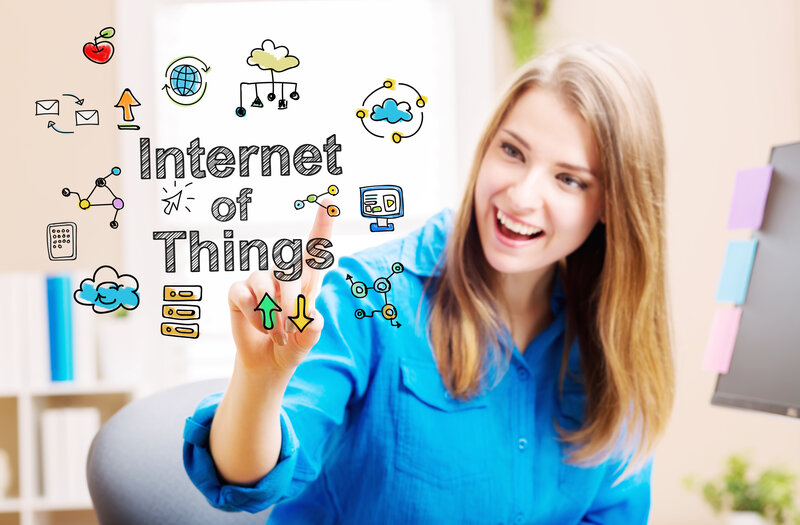
If you’re totally new to smart home IoT devices, understanding how all of these internet-connected devices work together can be a challenge. What exactly allows controlled devices to communicate, and how do you set up home automation using IoT?
Below, we’ll explain how the Internet of Things and home automation work together in a smart house. We’ll also discuss some applications of smart home devices, such as home appliances, smart mirrors, and smart security systems.
What Is The Internet of Things?
Put simply, the Internet of Things (IoT) consists of devices with an on/off switch that are connected to the internet. The Internet of Things didn’t get its name until 1999, but the concept has been floating around since the early 1980s.
One of the first examples of a device with IoT sensors was a Coca-Cola machine that connected to the internet at Carnegie Mellon University. Programmers could connect to the machine to see if drinks were in stock and chilled before heading over to buy one.
Today, we use IoT smart home devices such as smart refrigerators, air conditioning units, and sensors that can detect intruders on our properties.
How Does A Smart Home Automation System Work?
An IoT automation system works by connecting to remote servers on a cloud network. The main device that manages everything via cloud services is a controller, often called a central hub or gateway.
This controller connects to your home’s router via an Ethernet cable. IoT home sensors receive commands through this connection, and it’s possible to set up a specific sequence of actions (such as unlocking your door and then turning on the TV).
All commands are sent to the hub or gateway, and then the hub sends commands to home automation IoT sensors via an online interface. Because all of this data stays in the cloud, you can send commands to your IoT home automation system no matter where you are. This comes in handy, for instance, if you’re away on vacation and forget to turn off the lights.
One interesting thing about smart home infrastructure is that you can set up commands for smart controllers in an “If This, Then That” (ITTT) configuration. This means that the smart sensors will only perform an action if certain criteria are met.
For example, proximity and video sensors will only send an alarm to your phone if someone suspicious comes onto your property. To illustrate further, a smart irrigation system will only water your plants if it hasn’t rained recently.
Internet of Things And Home Automation Applications For Smart Devices
Now that you have a better idea of how smart homes and IoT work, let’s explore a few exciting smart home technologies that can make your life easier, safeguard your property, and boost the energy efficiency of your home.
Smart home technology and security systems
If you live in a high-crime area, simply leaving your house to go to work in the morning can be unnerving. Enter the smart security system, which enables you to protect your home and family from any remote location with a simple smartphone app.
With home security controls, you can remotely monitor security cameras and see what’s happening in and around your property, no matter the time of day. Many of these cameras also have smart motion controllers that alert you if a person or animal crosses into your yard.
Smart door locks are a must-have for home security, too. You can set a smart lock to only open the door when it recognizes you and your family. Some locks for smart homes also feature cameras so you can see who’s ringing the doorbell.
Smart sensor and alarm systems
Few things are worse than a fire breaking out at your home when you’re not there to do anything about it. Smart smoke controllers contain safety sensors that monitor temperature and humidity levels and then alert you if they detect a possible blaze. These units can also interface with your HVAC system and disable it to cut down on smoke inhalation.
Smart carbon monoxide detectors can also be true lifesavers for your family. These devices can send an alert to your phone or notify emergency personnel if they detect carbon monoxide.
Home Automation in the Bathroom
Stepping into an ice-cold shower in the morning isn’t anyone’s idea of a good time. Smart shower controls make your getting-ready routine much more enjoyable by automatically adjusting the shower to your preferred temperature.
You may have seen IoT smart home mirrors in movies, but they’re not the stuff of science fiction anymore. These mirrors can display news and videos from other connected devices, such as your laptop, to keep you entertained while you get ready for your day.
IoT home automation devices in the kitchen
Have you ever burned dinner because you got distracted by a phone call or your favorite TV show? If that sounds familiar, you’ll love the smart oven.
This handy appliance sends an alert to your phone when it’s time to eat — no more ruined pot roasts! You can also adjust the temperature from your phone to spare yourself an extra trip to the kitchen.
You can even connect your smart TV and coffee machine. For instance, you could trigger the TV to turn on whenever you brew your morning cup of joe.
Home automation lighting systems and mood-sensing music systems
Smart home lighting systems gently wake you up in the morning by turning on dim lights or opening shades to let in the first rays of the sun. You could also set your smart lighting system to dim the lights when you turn on the TV or brighten them when you sit down at your desk.
In addition, smart music systems can be a fun addition to your home. You can program your system to turn on energizing music when you start a workout or set it to play soothing tunes when you dim the lights.
Temperature control automation
If you’re sick of spending hundreds on electric bills, smart thermostats are the solution. With little more than a reliable internet connection, these intelligent heating and cooling systems automatically maintain the temperature in your home. Plus, like other energy-saving smart devices, you can adjust the temperature from anywhere using your phone.
Smart plugs
Smart plugs may look rather basic, but they can be incredibly useful if you (or your kids) are guilty of leaving electronics running when you’re not at home.
With a smart plug, you can turn devices on or off from anywhere using your phone. They also allow you to schedule devices to turn on and off at certain times of the day.
Plus, smart plugs are easy to use. Simply plug them into your wall, connect a device, and hook it up to the internet. It’s also possible to pair smart plugs with a virtual assistant, such as Google Home or Amazon Alexa.
Home automation systems for your lawn and garden
If mowing and watering your lawn has become a major pain, consider smart lawnmowers and irrigation systems. These high-tech gadgets take care of boring yard work so you don’t have to.
Full Spectrum Technology Group Handles All Your Home Automation Needs
Now that you’ve learned what the Internet of Things and home automation can do, we welcome you to learn more about setting up smart devices in your home. We can help you choose the right devices, give you an estimate, and walk you through every step of the installation process.
To find out more about our automation services, contact us at (925) 815-8324 today.
